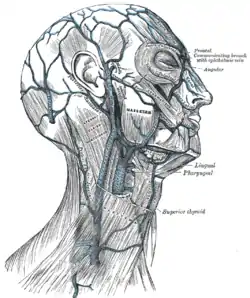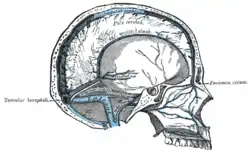Occipital vein
The occipital vein begins as a plexus at the posterior aspect of the scalp from the external occipital protuberance and superior nuchal line to the back part of the vertex of the skull.
| Occipital vein | |
|---|---|
 Veins of the head and neck. (Occipial visible at left.) | |
 Lateral head anatomy detail | |
| Details | |
| Drains from | scalp, occiput |
| Drains to | suboccipital venous plexus |
| Artery | occipital artery |
| Identifiers | |
| Latin | venae encephali occipitales |
| TA98 | A12.3.04.013 |
| TA2 | 4781 |
| FMA | 50802 |
| Anatomical terminology | |
From the plexus emerges a single vessel, which pierces the cranial attachment of the Trapezius and, dipping into the venous plexus of the suboccipital triangle, joins the deep cervical and vertebral veins.
Occasionally it follows the course of the occipital artery and ends in the internal jugular; in other instances, it joins the posterior auricular vein and through it opens into the external jugular vein.
The parietal emissary vein connects it with the superior sagittal sinus; and as it passes across the mastoid portion of the temporal bone, it receives the mastoid emissary vein which connects it with the transverse sinus.
The occipital diploic vein sometimes joins it.
Additional images
 Sagittal section of the skull, showing the sinuses of the dura.
Sagittal section of the skull, showing the sinuses of the dura.
References
This article incorporates text in the public domain from page 646 of the 20th edition of Gray's Anatomy (1918)
External links
